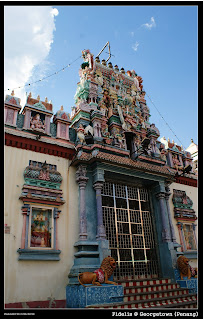
图41:Hock Teik Cheng Sin Temple
“The Hock Teik Cheng Sin at Armenian Street is a place with many different names. Founded in 1844, the Hock Teik Cheng Sin moved to its present site in 1850. It is most popularly known as the Hokkien Tua Pek Kong Temple, after its patron deity, the Taoist god of prosperity. But due to its past as the base of the Khian Teik Tong secret society, the Hock Teik Cheng Sin is also known by the names of the many societies which the Khian Teik Tong registered in its place, including the Poh Hock Seah, the Hokkien Kongsi, Cheng Hoe Seah and Tong Kheng Seah. These legitimately registered societies were created when the British authorities outlawed the Khian Teik secret society in 1890. It simply transferred its assets to these societies. The Poh Hock Seah inherits the religious functions of the Khian Teik in running the Hokkien Tua Pek Kong temples in Armenian Street as well as at the Tanjong Tokong Tua Pek Kong Temple, where the annual flame watching ritual called Chneah Hoay is conducted. ”http://www.asiaexplorers.com/malaysia/hockteikchengsin_temple.htm
---------------------------------------------

图42:Cheah Kongsi
“Cheah Kongsi is one of the most charming clan houses tucked away in a hidden recess of George Town.Although there is no record to show what year the Cheah Kongsi was founded, based on the title deeds, it can be deduced that the kongsi was founded somewhere before the year 1820, making it the oldest of the five major Hokkien clan associations in Penang, the others being the Khoo, Yeoh, Lim and Tan clan associations. The founder is attributed to be one Cheah Yam. Between then and 1858, the association acquired several pieces of land. The one on which the clan temple now stands was acquired in 1858 at Armenian Street. It took 15 years to build.
Within the halls of the Cheah Kongsi temple are the two main deities of the Cheahs. They were in fact extinguished generals who were bestowed the title of "Marquis" or "Hock Haw". ”http://www.asiaexplorers.com/malaysia/cheah_kongsi.htm
------------------------------------------

图43:宝珠社POE CHOO SEAN
历史不详
------------------------------------------

图44:陈氏宗祠
1857年檳城就成立了陳氏宗祠,稱為穎川堂陳公司。該宗祠的20名信理中,有18名是福建人,潮州和廣東人只是各占一名,結果引起一些不滿。粵籍同鄉乃成立純廣東人的庇能廣東陳氏宗祠。瓊州人則組織了檳城瓊崖陳氏宗祠,福建南安潮塘鄉人則組織陳氏潮塘社,惠州人成立宗盟社陳氏宗祠,福建十縣人組成陳氏聯宗社,還有不分籍貫的陳氏宗義社。此外檳城威省有陳氏穎川堂、大山腳陳氏穎川堂,合計檳城共有9個陳氏組織。該州的林氏宗祠更多達14個。
----------------------------------------

图45:Mahamariamman Temple
建于1833年,是印度街的一个象征,也是最古老的印度庙。This is the oldest Hindu temple in town, dating to 1833, with a magnificently sculptured entrance gate. At the end of Lebuh Queen is the Penang Teochew Association, a 19th century South Chinese district association temple. Note the granite beams and the beautifully gilded paintings of door gods at the facade.
-------------------------------------------------

图46:Teo chew Temple
原建与1855年,目前的建造物建与1870年
“The Han Jiang Ancestral Temple is the community temple of the Penang Teochew Association. The association was form in 1855 by six Teochew migrants. At first they started a lodging house for newly arrived Teochews. It was located at 381 Beach Street. In 1867, they purchased the land along Chulia Street to construct the community temple. The Hanjiang Ancestral Temple was completed in 1870. At the time of completion, it was known as the Teochew Kongsi. It only changed its name to Han Jiang Ancestral Temple in 1935.The Teochew is one of six main Chinese dialect groups in Malaysia. The Teochews originate from Chaozhou prefecture, on the eastern part of Guangdong province, bordering Fujian province, in southern China. Early Teochew immigrants arrived in Penang in the mid-19th century and settled as plantation workers in Province Wellesley. Later some moved to George Town, where they established themselves in the wholesale and dried foodstuff trades.From the late 18th to the early 20th centuries, Chinese migrants to the Nanyang (that is to say, Southeast Asia), form mutual benefitting guilds, not unlike the merchant guilds or Hansa prevailing in mediaval Europe at that time. These guilds or associations are usually based on the people's district of origin, dialect, surname, clan or occupational group. For this reason, we can find in George Town today such associations as the Khoo Kongsi, for the Khoo clan, Teochew association, for the Teochew dialect group, and Carpenter's Guild, the association of carpenters. These associations act as a safe house for early immigrants to find shelter before establishing themselves in the new land.
The original Teochew temple was in the form of si dian jing, or four-point gold. This is a quadrangle design with an inner courtyard, or atrium. In 1890, an outer gate was added. In reflection of the prosperity of the community at that time, the gate was even more ornate than the original temple. It also has one of the biggest doors of any clan temples in Penang.The Han jiang Ancestral Temple houses the altar to the Teochew patron deity, the Taoist god of the north as well as ancestral tablets of deceased Teochews. In keeping with the high status of the temple's patron deity, the Teochew temple features three pairs of doors instead of only one for most temples.”
www.asiaexplorers.com/malaysia/hanjiang_teochew_ancestral_temple.htm
----------------------------------------------

图47:Bangunan U.A.S
U.A.S为 United Asian Bank,历史不详
-------------------------------------------------

图48:荣昌公司
历史不详,荣昌公司为1920年从菲律宾归来的李清泉和其叔父李昭北一同组织的公司。
----------------------------------------------

图49:槟城街景之Penang Road
“The road was constructed and named in 1906. It served traffic moving from Tank Road to the railway bridge at Fort Canning Road. Situated near Orchard Road, this road is a part of the commercial and shopping hub of Singapore. The road runs behind the Istana Park and is connected to the Dhoby Ghaut MRT station through an underpass. ”
---------------------------------------------
建于1818年,槟城最悠久的英式教堂。去了很多次,不过还没有一次遇过开门的。
“Named after the patron saint of England. Built by convict labour in 1818, it is the oldest Anglican Church in South-East Asia.This is the oldest Anglican church in the country, modelled after a large church in Madras. In front of the church is a handsome memorial to Francis Light, who died on October 21, 1794. The Church maintains much of its original setting. ”
en.wikipedia.org/wiki/St._George's_Church_Penang
en.wikipedia.org/wiki/St._George's_Church_Penang



没有评论:
发表评论